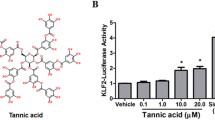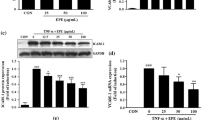Abstract
Xylopic acid (XA) is a kaurene diterpene which naturally exists in African plants such as Xylopia aethiopica. It has been established to exhibit acute and chronic anti-inflammatory activities from our earlier studies. This current work sets out to shed light on the potential molecular target(s) of xylopic acid. Selection of investigated targets (NF-κB, Nrf2 and PTP1B) was based on an unbiased approach, using the SPiDER in silico prediction tool, and a candidate approach, examining well-known anti-inflammatory targets. Reporter gene assays were used to test for altered NF-κB and Nrf2 activities in transfected HEK or CHO cells, respectively, and immunoblot and flow cytometric analyses examined protein expression of the Nrf2/NF-kB target genes HO-1 and VCAM-1 in HUVEC. An effect of XA on PTP1B activity assay was studied using an in vitro enzyme assay with recombinant human enzyme and pNPP as substrate as well as by looking at insulin receptor phosphorylation in HepG2 cells. XA at 30 µM significantly (p < 0.001) inhibited the NF-κB-dependent reporter gene expression and enhanced activation of Nrf2 in a concentration-dependent manner when compared to the control. XA also marginally increased HO-1 protein expression levels while expression of VCAM-1 was reduced to 70% in XA-treated endothelial cells. However, XA did not show any sign of inhibition of PTP1B or a related phosphatase. Our findings suggest that the anti-inflammatory mechanism of XA entails the inhibitory effect on NF-κB and an increased activity of Nrf2, accompanied by increased expression of HO-1 and reduced expression of VCAM-1.




Similar content being viewed by others
Data availability
The datasets generated during and/or analyzed during the current study are available from the corresponding author on reasonable request.
References
Alolga RN, Opoku-Damoah Y, Alagpulinsa DA, Huang F-Q, Ma G, Chavez MASC, Leon CK, Yin X, Ding Y (2021) Metabolomic and transcriptomic analyses of the anti-rheumatoid arthritis potential of xylopic acid in a bioinspired lipoprotein nanoformulation. Biomaterials 268:120482. https://doi.org/10.1016/j.biomaterials.2020.120482
Ameyaw EO, Woode E, Boakye-Gyasi E, Abotsi WKM, Kyekyeku JO, Adosraku RK (2014) Anti-allodynic and anti-hyperalgesic effects of an ethanolic extract and xylopic acid from the fruits of xylopia aethiopica in murine models of neuropathic pain. Pharmacognosy Research 6(2):172–179. https://doi.org/10.4103/0974-8490.129041
Anon. n.d. ‘Oxidative stress and diabetic complications’. Retrieved 8 Oct 2021a (https://www.ncbi.nlm.nih.gov/pmc/articles/PMC2996922/)
Anon. n.d. ‘TNFα increases hypothalamic PTP1B activity via the NFκB pathway in rat hypothalamic organotypic cultures - PubMed’. Retrieved 8 Oct 2021b (https://pubmed.ncbi.nlm.nih.gov/22166493/).
Atanasov AG, Zotchev SB, Dirsch VM et al (2021) Natural products in drug discovery: advances and opportunities. Nat Rev Drug Discov 20:200–216. https://doi.org/10.1038/s41573-020-00114-z
Banning A, Brigelius-Flohé R (2005) NF-kappaB, Nrf2, and HO-1 interplay in redox-regulated VCAM-1 expression. Antioxid Redox Signal 7(7–8):889–899. https://doi.org/10.1089/ars.2005.7.889
Campbell NK, Fitzgerald HK, Dunne A (2021) Regulation of inflammation by the antioxidant haem oxygenase 1. Nat Rev Immunol 21(7):411–425. https://doi.org/10.1038/s41577-020-00491-x
Dhalla NS, Temsah RM, Netticadan T (2000) Role of oxidative stress in cardiovascular diseases. J Hypertens 18(6):655–673. https://doi.org/10.1097/00004872-200018060-00002
Giacco F, Brownlee M (2010) Oxidative stress and diabetic complications. Circ Res 107(9):1058–1070. https://doi.org/10.1161/circresaha.110.223545
Hartenfeller M, Schneider G (2011) Enabling future drug discovery by de novo design. Adv Rev 1(5):742–759. https://doi.org/10.1002/wcms.49
Heiss EH, Schilder YDC, Dirsch VM (2007) Chronic treatment with resveratrol induces redox stress- and ataxia telangiectasia-mutated (ATM)-dependent senescence in p53-positive cancer cells. J Biol Chem 282(37):26759–26766. https://doi.org/10.1074/jbc.m703229200
Heiss EH, Baumgartner L, Schwaiger S, Heredia RJ, Atanasov AG, Rollinger JM, Stuppner H, Dirsch VM (2012) Ratanhiaphenol III from ratanhiae radix is a PTP1B inhibitor. Planta Med 78(7):676–681 https://doi.org/10.1055%2Fs-0031-1298242
Ito Y, Banno R, Hagimoto S, Ozawa Y, Arima H, Oiso Y (2012) TNFα increases hypothalamic PTP1B activity via the NFκB pathway in rat hypothalamic organotypic cultures. Regul Pept 174(1–3):58–64. https://doi.org/10.1016/j.regpep.2011.11.010
Ji H-F, Li X-J, Zhang H-Y (2009) Natural products and drug discovery. Can thousands of years of ancient medical knowledge lead us to new and powerful drug combinations in the fight against cancer and dementia? EMBO Rep 10(3):194–200. https://doi.org/10.1038/embor.2009.12
Kong D-H, Kim YK, Kim MR, Jang JH, Lee S (2018) Emerging roles of vascular cell adhesion molecule-1 (VCAM-1) in immunological disorders and cancer. Int J Mol Sci 19(4):E1057. https://doi.org/10.3390/ijms19041057
Kropat C, Mueller D, Boettler U, Zimmermann K, Heiss EH, Dirsch VM, Rogoll D, Melcher R, Richling E, Marko D (2013) Modulation of Nrf2- dependent gene transcription by bilberry anthocyanins in vivo. Mol Nutr Food Res 57(3):545–550. https://doi.org/10.1002/mnfr.201200504
Liu T, Zhang L, Joo D, Sun S-C (2017) NF-κB signaling in inflammation. Signal Transduct Target Ther 2:17023. https://doi.org/10.1038%2Fsigtrans.2017.23
Nathan C (2002) Points of control in inflammation. Nature 420(6917):846–852. https://doi.org/10.1038/nature01320
Nathan C, Ding A (2010) Nonresolving inflammation. Cell 140(6):871–882. https://doi.org/10.1016/j.cell.2010.02.029
Osafo N, Biney RP, Obiri D (2016) Aqueous ethanol fruit extract of xylopia aethiopica and xylopic acid exhibit anti-inflammatory activity through inhibition of the arachidonic acid pathway. Pharm Biosci J 4(6):35–41. https://doi.org/10.20510/UKJPB/4/I6/134665
Osafo N, Obiri DD, Antwi AO, Yeboah OK (2018) The acute anti-inflammatory action of xylopic acid isolated from Xylopia Aethiopica. J Basic Clin Physiol Pharmacol 29(6):659–669. https://doi.org/10.1515/jbcpp-2018-0019
Osafo N, Obiri DD, Danquah KO, Essel LB, Antwi AO (2019) Potential effects of xylopic acid on acetic acid-induced ulcerative colitis in rats. Turk J Gastroenterol 30(8):732–744. https://doi.org/10.5152/tjg.2019.18389
Rajan S, Ye J, Bai S, Huang F, Guo Y-L (2008) NF-ΚB, but not P38 MAP kinase, is required for TNF-α–induced expression of cell adhesion molecules in endothelial cells. J Cell Biochem 105(2):477–486. https://doi.org/10.1002/jcb.21845
Reuter S, Gupta SC, Chaturvedi MM, Aggarwal BB (2010) Oxidative stress, inflammation, and cancer: how are they linked? Free Radical Biol Med 49(11):1603–1616. https://doi.org/10.1016/j.freeradbiomed.2010.09.006
Reutlinger M, Koch CP, Reker D, Todoroff N, Schneider P, Rodrigues T, Schneider G (2013) Chemically advanced template search (CATS) for scaffold-hopping and prospective target prediction for “orphan” molecules. Mol Inf 32(2):133–138. https://doi.org/10.1002/minf.201200141
Saha S, Buttari B, Panieri E, Profumo E, Saso L (2020) An overview of Nrf2 signaling pathway and its role in inflammation. Molecules 25(22):5474. https://doi.org/10.3390%2Fmolecules25225474
Schneider P, Schneider G (2016) De novo design at the edge of chaos. J Med Chem 59(9):4077–4086. https://doi.org/10.1021/acs.jmedchem.5b01849
Schneider P, Stutz K, Kasper L, Haller S, Reutlinger M, Reisen F, Geppert T, Schneider G (2011) Target Profile Prediction and practical evaluation of a biginelli-type dihydropyrimidine compound library. Pharmaceuticals 4(9):1236–1247. https://doi.org/10.3390/ph4091236
Son Y, Lee JH, Chung H-T, Pae H-O (2013) Therapeutic roles of heme oxygenase-1 in metabolic diseases: curcumin and resveratrol analogues as possible inducers of heme oxygenase-1. Oxid Med Cell Longev 2013:639541. https://doi.org/10.1155/2013/639541
Song GJ, Jung M, Kim J-H, Hana Park Md, Rahman H, Zhang S, Zhang Z-Y, Park DH, Kook H, Lee I-K, Suk K (2016) A Novel role for protein tyrosine phosphatase 1B as a positive regulator of neuroinflammation. J Neuroinflammation 13(1):86. https://doi.org/10.1186/s12974-016-0545-3
Tak PP, Firestein GS (2001) NF-KappaB: a key role in inflammatory diseases. J Clin Investig 107(1):7–11. https://doi.org/10.1172/JCI11830
Vijayan V, Mueller S, Baumgart-Vogt E, Immenschuh S (2010) Heme oxygenase-1 as a therapeutic target in inflammatory disorders of the gastrointestinal tract. World J Gastroenterol 16(25):3112–3119. https://doi.org/10.3748/wjg.v16.i25.3112
Vomhof-DeKrey EE, Picklo MJ (2012) NAD(P)H: quinone oxidoreductase 1 activity reduces hypertrophy in 3T3-L1 adipocytes. Free Radical Biol Med 53(4):690–700. https://doi.org/10.1016/j.freeradbiomed.2012.05.047
Zabolotny JM, Kim Y-B, Welsh LA, Kershaw EE, Neel BG, Kahn BB (2008) Protein-tyrosine phosphatase 1B expression is induced by inflammation in vivo. J Biol Chem 283(21):14230–14241. https://doi.org/10.1074/jbc.M800061200
Acknowledgements
We wish to express our profound gratitude to the Wilmar Schwabe Research Fellowship from the Society of Medicinal Plants and Natural Products Research (to YDB) for their support to enable this work possible. The authors thank the molecular target research team in the Department of Pharmacognosy, University of Vienna.
Funding
The authors have not disclosed any funding.
Author information
Authors and Affiliations
Corresponding author
Ethics declarations
Conflict of interest
Yaw Duah Boakye has no conflict of interest. Newman Osafo has no conflict of interest. James Oppong-Kyekyeku has no conflict of interest. Wonder Kofi Mensah Abotsi has no conflict of interest. Eric Boakye-Gyasi has no conflict of interest. Elke Heiss has no conflict of interest. Christian Agyare has no conflict of interest.
Additional information
Publisher's Note
Springer Nature remains neutral with regard to jurisdictional claims in published maps and institutional affiliations.
Supplementary Information
Below is the link to the electronic supplementary material.
Rights and permissions
About this article
Cite this article
Boakye, Y.D., Osafo, N., Oppong-Kyekyeku, J. et al. Regulation of Nrf2 and NF-κB activities may contribute to the anti-inflammatory mechanism of xylopic acid. Inflammopharmacol 30, 1835–1841 (2022). https://doi.org/10.1007/s10787-022-00950-y
Received:
Accepted:
Published:
Issue Date:
DOI: https://doi.org/10.1007/s10787-022-00950-y




